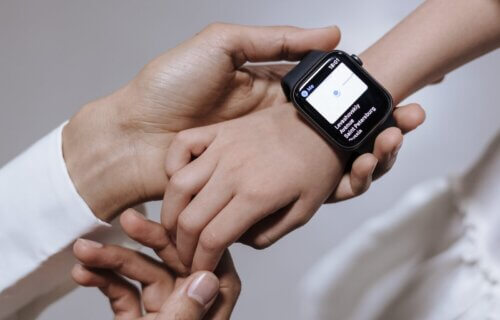PALO ALTO, Calif. — Smartwatches can aid doctors in detecting irregular heartbeats in children, new research reveals. Scientists at the Stanford School of Medicine have discovered that smartwatches, which continuously monitor the wearer’s heart rate, can be instrumental in diagnosing abnormal heart rhythms in kids. These devices have proven more effective than traditional methods, which children often find invasive.
The study highlighted that Apple smartwatches were referenced 145 times in patients’ medical records over four years. Notably, 29 children were diagnosed with arrhythmia for the first time using data from these devices.
The researchers note that smartwatches have shown great potential in monitoring and identifying unusual heart rhythms in children. For example, a young boy in California was diagnosed with a heart rhythm disorder after using his mother’s smartwatch to record and send data to his doctor during a medical episode.
Doctors face two major challenges when diagnosing cardiac arrhythmias in children. Firstly, existing heart-monitoring devices are not ideal for children. Previously, children wore Holter monitors, which are bulky and uncomfortable. Nowadays, kids can use less invasive “event monitors,” but these often detach and can irritate the skin.
Secondly, the unpredictable nature of arrhythmias in children makes diagnosis difficult. Even weeks of monitoring might not capture a child’s erratic heart rhythm.

Connor Heinz, a 15-year-old from California, exemplified these challenges. He experienced sporadic racing heartbeats, and adhesive monitors were too irritating. His doctor, Dr. Scott Ceresnak, the senior author of this study, suggested using a smartwatch to record Connor’s heart rhythm during these episodes.
A limitation of using smartwatches is that the algorithms for detecting heart problems are not yet optimized for children, who have faster heartbeats and different types of abnormal rhythms compared to adults. However, Dr. Ceresnak’s study indicates that smartwatches could be effective in detecting arrhythmias in children, suggesting the need for child-specific smartwatch algorithms.
The study involved reviewing electronic medical records from 2018 to 2022 for mentions of “Apple Watch.” It was found that 41 patients had confirmed arrhythmias, with 18 of them collecting ECG data and 23 receiving high heart rate notifications from their watches. Additionally, 73 patients without arrhythmia diagnoses also had smartwatch data, leading to 29 new diagnoses.
In 10 cases, smartwatches identified arrhythmias that traditional methods had missed. Among these was Connor, who was diagnosed with supraventricular tachycardia from data his mother sent to Dr. Ceresnak. Most children with arrhythmias, like Connor, experience rapid heartbeats originating in the heart’s upper chambers, often caused by a small electrical short-circuit in the heart. These can often be cured with a catheter ablation procedure. After successful treatment, Connor returned to playing basketball for his high school team in Menlo Park, California.
“These irregular heartbeats are not life-threatening, but they make kids feel terrible,” Ceresnak says in a university release. “They can be a problem and they’re scary, and if wearable devices can help us get to the bottom of what this arrhythmia is, that’s super helpful.”
“A lot of kids have palpitations, a feeling of funny heartbeats, but the vast majority don’t have medically significant arrhythmias,” Ceresnak explains. “In the future, I think this technology may help us rule out anything serious.”
“I was surprised by how often our standard monitoring didn’t pick up arrhythmias and the watch did,” says Ceresnak, the senior study author and a professor of pediatrics. “It’s awesome to see that newer technology can really make a difference in how we’re able to care for patients.”
Dr. Ceresnak’s team now plans to conduct further studies to assess the usefulness of the Apple Watch in detecting children’s heart problems. Future studies will measure whether heart rhythm measurements from watches worn by children match measurements from standard diagnostic devices.
The findings are published in the journal Communications Medicine.
You might also be interested in:
- Best Apple Watch Alternatives: Top 5 Smartwatches Most Recommended By Techies
- Smartwatches and wearable fitness trackers could trigger heart attacks in vulnerable patients
- The shape of your heart could reveal your risk for AFib
South West News Service writer James Gamble contributed to this report.


Thank your murderous government for the kill shots. Death to government traitors. CVHOAX.COM
Who cares, as long as Democrats get elected. Free everything.
It is the poison shots.
Put Pfizer and Moderna out of business and put Fauci and Collins in jail.
To establish cause, you conduct a retroactive study. And see patterns of risk among the subjects. Such as the COVID vaccine or opiate use. Perhaps there are other patterns that stand out. Such as young males receiving the vaccine.
This is very poor “research.” It fails to even qualify as science.
To establish cause, you conduct a retroactive study. And see patterns of risk among the subjects. Such as the COVID vaccine or opiate use. Perhaps there are other patterns that stand out. Such as young males receiving the vaccine.
This is very poor “research.” It fails to even qualify as science.
As expected from a genocidal bioweapon.
Opioid use and poor hygiene are both new to the world ? Hmm wonder why this isn’t rampant among all age groups using and with poor hygiene? Not the droids you’re looking for….
Probably more likely the vaccine
This is CLEARLY a COVID vaccine related issue. Why didn’t the article touch in that obvious point. Everyone is thinking this. Everyone.
Curious, any studies compare this issue with Vax status? Just sayin….
Nonsense, it’s the vaccine!
You mean, people who already have heart problems will have another heart problem?
This sounds like twisting info to produce fear among the stupid.
Q: What’s the best part about being a conspiracy theorist?
A: Not having myocarditis or blood clots